Reflection of Independent Learning in the Classroom
| ✅ Paper Type: Free Essay | ✅ Subject: Teaching |
| ✅ Wordcount: 2266 words | ✅ Published: 08 Sep 2017 |
Reflecting on the approaches around the development of pupils’ independent learning and evidence and evaluate application in the classroom.
‘Independent learning is when pupils set goals, monitor and evaluate their own academic development, so they can manage their own motivation towards learning’ (Mullings 2015). After looking into the research, one of the determining factors when it comes to independent learning, is getting a child to work on their own, with minimal direction and confidence. As I want my pupils to be able to manage their own learning and make independent decisions, I need to take a back seat and critically think about whether or not I need to intervene. Depending on the circumstances and the appropriateness of the situation, I will need to judge the relevance of my scaffolding, give students options and choices to encourage independency, and allow them to take responsibility for their own learning by also offering effective formative feedback.
However, this cannot be done until I establish where they already are in their learning and how they actually learn. Knowing a child’s zone of proximal development, will enable me to intervene at the most appropriate and effective stage. As Vygotsky’s theory implies, it is what a child can achieve by themselves and what they can achieve in collaboration with others (Vygotsky, 1978).
According to Haring and Easton’s instructional hierarchy (Fig 1), there are four phases of learning (Haring et al., 1978).
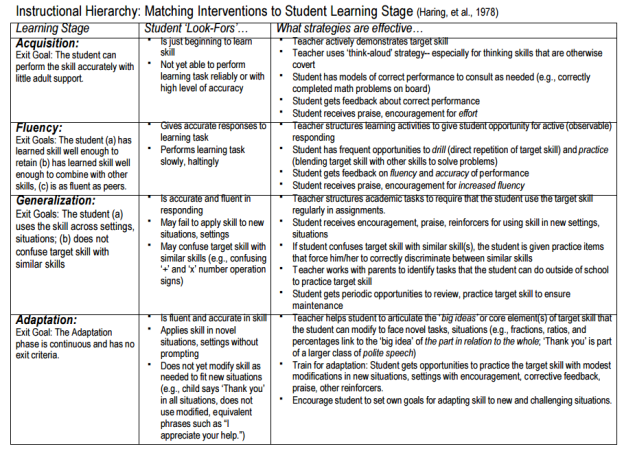
Fig 1.
Most of the children I get to support are either at the acquisition stage or at the ‘halting’ fluency stage, which determines the type of intervention they receive. Even if the intervention is set in line with the pupils ZPD, there is no guarantee that their work is appropriately differentiated back in the classroom, leading to a zone of anxiety.
When I deliver Mind-the-Gap tutoring, the pupils I work with are at the acquisition stage and lack confidence. With sessions of repetitive practice and instructional techniques I am able to build upon their accuracy. I then focus on training the pupils to become more fluent. This is supported via precision teaching (e.g. times-tables) constant encouragement and instructional feedback to aid their self-motivation. Once the fluency is achieved and being maintained, I need to ensure it is being applied back in the classroom. The focus is then teaching them how to either apply the skill into meaningful contexts or not to confuse it with other similar skills. Finally, pupils can then be scaffolded on how to know how to adapt the target skill to and apply it to new challenges and situations. Communication is paramount and teamwork essential to ensure work is set at the right level by the teacher and that the newly acquired skills are being uitilised. ‘the teacher should work closely with the TA to planinterventions to how they can be linked to classroom teaching’ (SEN Code-of-Practice 6.52). I have started to introduce additional resources, such as a math mat and progressive success criteria to help promote independency. If successful, I will suggest it to other support staff within my year group, with the view to it being rolled out to all. I will need the full support of the SENCo and SLT to make sure this is consistently implemented.
Carol Dweck deals with the theory that people view their intelligence in one of two ways; fixed and growths mindsets (Fig 2). Her findings also show that, rather than focusing on intelligence and innate achievement, it is far more important to reward effort, creative strategies, and perseverance. ‘Becoming is better than being’ (Dweck 2006).
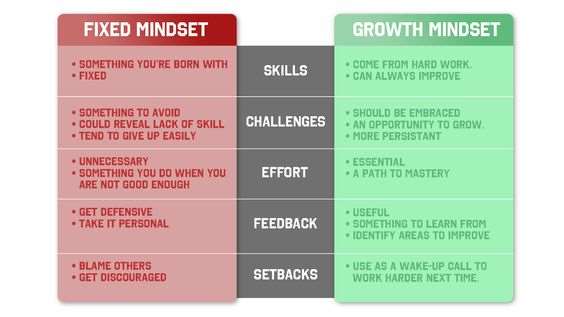
Fig 2.
Upon reflection, I observed two children from the perspective of determining what type of learner each child was (Appendix 1). Initiating the change of learned helplessness to that of self-scaffolding with the SEN child will not happen overnight. I always aim to support pupils to become more independent. Van de Pol implies a key principle of scaffolding on which a TA’s role should be based, is fading to develop the independence of the learner by reducing support and hand over responsibility to the child (Van de Pol et al., 2010). This is a strategy I have started to use with the pupils I work with, alongside ‘roaming and roving’ around the classroom.
My intention is purely to divorce myself from their learned attachment and their needing constant reassurance. I want them to adopt the concept of being able to assess what they can do independently first, before I intervene at the appropriate level (Fig 3). Blatchford defines the ‘heuristic’ role as ‘using a method of teaching that encourages learners to discover solutions for themselves’ (Blatchford et al., 2012).
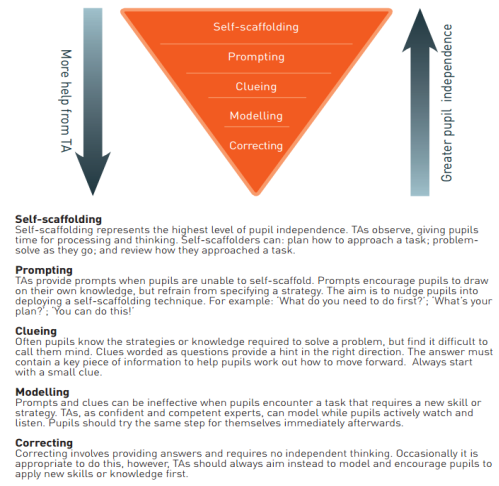
Fig 3.
If there is any uncertainty, I encourage my pupils to ask a partner, throw their question out to the rest of the table or see what resources are available to help, before even thinking about asking an adult. Even then, I need to be aware of my questioning techniques. The more open ended questions that are asked, then the more emphasis is redirected back onto the pupil to provoke their own critical thinking skills. ‘The cognitive domain involves knowledge and the development of intellectual skills’ (Bloom, 1956).
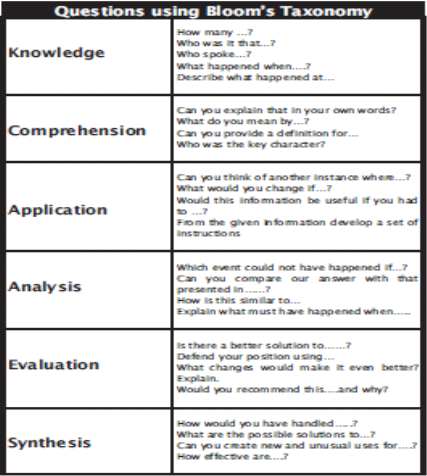
Fig 4.
Using Blooms Taxonomy questioning for critical thinking as a bench mark (Fig 4), I have tailored a more ‘child friendly’ set of questioning cards as a pupil resource, helping to build upon their dialogic talk. I plan to share these with other support staff, with SLT’s approval. Additionally, my school has implemented ‘Talk 4 Learning’ strategies, which although at the early stages, have started to have a positive effect.
Within one year group I observed, children were only provided with a learning objective and modelled WAGOLL. This seemed to be just enough to get by on with a majority of the class, but the lower attainers had no differentiated input, with the hope that the TA would offer that much needed support. The lower attainers had been given very little direction, so straight away looked to the TA for guidance. The TA aimed to guide the pupils through a series of open ended questions, praising when giving a correct answer. Some were prompted further with the aim of trying to refer back to previous lessons, but without the correct scaffolding and feedback little progress was made.
John Hattie, famously analysed the effects of various educational innovations and methods and determined that feedback ranked highest, with an effect size of 1.13, whereas most innovations in schools sit around 0.4. Feedback needs to be formative to identify what pupils have achieved, what has been preventing them from achieving their learning goals and what they can do to improve further. It also needs to be progressive, done whilst pupils are still able to reflect upon the decisions they made.
This can be effectively delivered when ‘roaming and roving’ or ‘fading’ in and out during a lesson, but after realising my own lack of informative feedback (appendix 2), I intend to ask SLT about CPD on feedback for TA’s, as I see this as a needed area of improvement for us all.
It has become quite apparent that processed success criteria is a much needed determiner when it comes to initiating the first stages of independent learning for the SEN child. I have recently been given a small group of lower attaining students to support with their math’s work. After observing how these children were faltering when working their way to achieving the learning intention (appendix 3), I have now started to use process success criteria to help plug the gaps within their learning, which has been hindering achieving their overall objective. I not only aim to help break down their ‘steps to success’ in written format but also where applicable, visually (Fig 5).
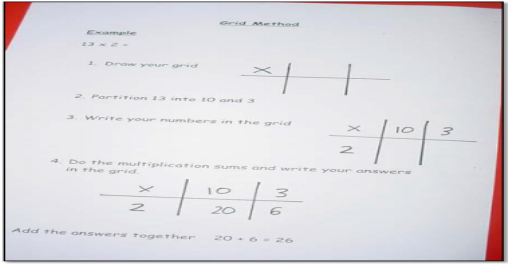
Fig 5.
So far, this has proved a successful strategy and has been fully embraced by the pupils, as they are now actively making progress independently, albeit resource supported. I will be trialing this as part of their assessment for learning, as success criteria should be linked to the learning, not the activity. Introducing AFL sheets will allow teachers to close the gap between current knowledge and new learning. Not only do they help clarify the learning objective and promote self-evaluation, they also act as a form of feedback. I have already liaised with an SLT member regarding the introduction of processed success criteria as a pre-requisite for all our lower attainers, to which he was in full agreement. Ironically, not long after our conversation, it was announced that as part of our high focus for this term that the school will be addressing how success criteria will be differentiated, so that they are appropriate for all children, and so that all groups make improved progress.
It has been said that some people think that we have created a nanny state that’s contributed to promoting fear of failure. John Cridland states that the education system must better prepare young people for life beyond the school gates. ‘We need to take a step back to see the big picture and create a system that better reflects how well a school’s culture nurtures the behaviours and attitudes young people need. This cannot be judged by exam results alone’ (Cridland 2014). I do agree, however, my concern is, given the expanding national curriculum and the focus on increased testing as a way to measure both teaching ability and pupil progression, how can time be found for the implementation of such productive concepts. Schools need to build a stronger foundation and utilise their support staff appropriately. I gave a copy of my first assignment on the role of the TA, to a member of SLT. The feedback I received initially was that it was very informative and provoked food for thought, so much so, he planned to take it along to the next SLT meeting. I eagerly await further comment.
Appendix 1
‘A’ always relies on the support of an adult to supply her with the answers. The first thing that she does is to look directly to the supporting adult in the room to come and work with her, without even attempting any independent work. A will always try to copy from whoever sits next to her, lacks confidence and fears making mistakes. She has a firm fixed mindset of learned helplessness which has resulted in her reliance on being spoon-fed.
‘Z’ is self-initiated and not afraid to make any mistakes. He can work independently or collaboratively within a group. Z draws upon prior learning His growth mindset allows him the confidence to persevere, seeing any setbacks as a mini hurdle he needs to overcome, choosing which learner disposition he takes on board to aid his learning. His positive attitude feeds his hunger for knowledge.
Appendix 2
Recorded Conversation
After a basic skills assessment of using visual arrays, mastery questions on applying the written grid method were required for their next steps in multiplication.
E:Miss, I’m not sure how to do the grid method.
TA:So, written method. Same scenario, but we are not going to draw the arrays. What is the calculation?
E:13 x 9.
TA:OK. What do you need to do first?
E:Break the 13?
TA:How?
E:Into place value.
TA:Correct. Show me how you’ll do that.
E:One 10 and three 1’s.
TA:Good. Now what?
E:First you times 3 by 9, then 10 x 9.
TA:OK, off you go.
E:(writes) 3 x 9 = 27 and 10 x 9 = 90.
TA:Good, now what do I do with those two answers?
E:Add them together.
TA:See. You know what to do. What do we need to remember when we use column addition?
E:Make sure everything is in line.
TA:Yes. We need to make sure our place value is aligned correctly. Well done!
Reflection:
Upon evaluation, I believe that I succeeded when it came to asking the appropriate open questions to provoke their own thinking, which helped them achieve their learning objective but evidently lacked the necessary more informative feedback the child deserved to understand their next target. I hope that I will be able to address this better after some directed CPD training.
Appendix 3
|
Child Y LO: To use the grid method to solve multiplication word problems. SC: R U C S A C |
|
|
CAN DO |
CAN’T DO |
|
Understood what had to be done for step 1 of question. |
|
|
Chose correct operation. |
|
|
Partitioned numbers correctly on the grid. |
|
|
|
|
|
Used times table grid in classroom. |
|
|
Aware that all the answers had to be added together. |
|
|
Addition calculation was written incorrectly. (pv not aligned) |
|
|
Able to calculate once prompted to use correct pv alignment. |
|
References
Blatchford, P., Russell, A., & Webster, R. (2012) Reassessing the impact of teaching assistants: How research changes practice and policy. Oxon, UK: Routledge.
Blooms Taxonomy Available at: http://www.bloomstaxonomy.org/Blooms%20Taxonomy%20questions.pdf Accessed: 1 January 2017.
Cridland, J. (2014) Available at:
http://31.222.129.40/media-centre/the-point/2014/07/jcs-education-blog/
Accessed: 07 December, 2016.
Dweck, Carol S. Mindset: the new psychology of success New York: Random House, 2006.
Haring, N.G., Lovitt, T.C., Eaton, M.D., & Hansen, C.L. (1978). The fourth R: Research in the classroom (pg 23-40). Columbus, OH: Merrill.
Hattie, J., & Timperley, H. (2007). The Power of feedback. Review of Educational Research
Mullings, C. (2015) Available at:
http://blog.irisconnect.co.uk/9-tips-for-encouraging-students-to-become-independent-learners/
Accessed: 12 December, 2016.
SEND Code of Practice (2015) Available at: https://www.gov.uk/government/uploads/system/uploads/attachment_data/file/398815/SEND_Code_of_Practice_January_2015.pdf Accessed: 26 December, 2016.
Van de Pol, J., Volman, M., & Beishuizen, J. (2010) Scaffolding in teacher-student interaction: a decade of research. Educational Psychology Review, 22, 382-296.
Vygotsky, L.S. (1978) Mind in society: The development of the higher psychological process. Cambridge, MA: Harvard University Press.
Cite This Work
To export a reference to this article please select a referencing stye below:
Related Services
View allDMCA / Removal Request
If you are the original writer of this essay and no longer wish to have your work published on UKEssays.com then please click the following link to email our support team:
Request essay removal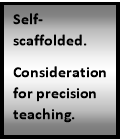
 Did not know all of 4x table.
Did not know all of 4x table.


